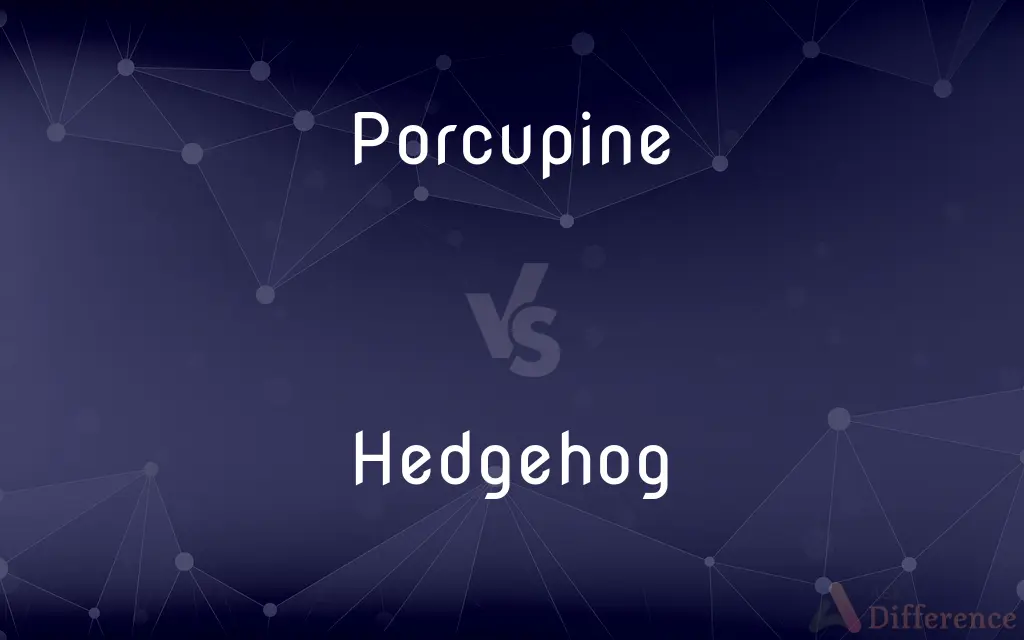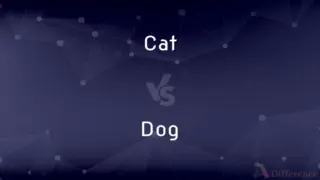Porcupine vs. Hedgehog — What's the Difference?
By Tayyaba Rehman — Updated on October 3, 2023
Porcupine: a large rodent with coats of sharp spines, or quills. Hedgehog: a small, spiny mammal, smaller than porcupines, and belonging to a different family, Erinaceidae.

Difference Between Porcupine and Hedgehog
Table of Contents
ADVERTISEMENT
Key Differences
Porcupines are rodents with a coat of sharp spines, or quills, that protect against predators. Conversely, Hedgehogs are small, spiny mammals, not rodents, and utilize their spines as a defense mechanism by curling into a ball.
Porcupines, belonging to the family Hystricidae or Erethizontidae, are found in the Americas, Europe, and Asia. Hedgehogs, however, hail from the family Erinaceidae and are native to parts of Europe, Asia, Africa, and New Zealand.
Porcupine quills are longer, barbed, and can detach easily to defend from predators. Hedgehog spines are shorter, smoother, and do not easily detach but provide protection when it rolls its body into a tight ball.
In terms of diet, Porcupines are primarily herbivorous, munching on a diet consisting of plants, fruit, and bark. Hedgehogs, however, have a varied diet, which includes insects, frogs, fruits, and even small snakes.
Porcupines tend to be larger, with some species weighing up to 60 pounds, and have a relatively long lifespan in the wild. Hedgehogs are significantly smaller, rarely exceeding 2 pounds, and generally have shorter lifespans than porcupines.
ADVERTISEMENT
Comparison Chart
Taxonomic Family
Hystricidae or Erethizontidae
Erinaceidae
Geographic Distribution
Americas, Europe, Asia
Europe, Asia, Africa, New Zealand
Physical Characteristic
Longer, barbed quills
Shorter, smoother spines
Diet
Primarily herbivorous
Omnivorous, incl. insects and small vertebrates
Defense Mechanism
Detachable quills
Rolls into a ball
Compare with Definitions
Porcupine
They belong to the family Hystricidae or Erethizontidae.
Porcupines are found in various global regions.
Hedgehog
A hedgehog is a small, spiny mammal, not a rodent.
The hedgehog curled into a ball when scared.
Porcupine
Porcupines are primarily herbivorous creatures.
The porcupine was busy munching on bark.
Hedgehog
Hedgehogs are found in parts of Europe, Asia, and Africa.
African hedgehogs are popular in the pet trade.
Porcupine
Porcupines have barbed quills that can detach easily.
Porcupine quills can become embedded in an attacker's skin.
Hedgehog
Hedgehogs roll into a tight ball as a defense mechanism.
A hedgehog's spines protect it while it sleeps.
Porcupine
A porcupine is a rodent with a coat of sharp spines.
The porcupine raised its quills when threatened.
Hedgehog
A hedgehog is a spiny mammal of the subfamily Erinaceinae, in the eulipotyphlan family Erinaceidae. There are seventeen species of hedgehog in five genera found throughout parts of Europe, Asia, and Africa, and in New Zealand by introduction.
Porcupine
Porcupines can be found in the Americas, Europe, and Asia.
The North American porcupine is the largest of all porcupines.
Hedgehog
Any of several small insectivorous mammals of the subfamily Erinaceinae, native to Eurasia and Africa and naturalized in New Zealand, having dense erectile spines covering the back and sides and characteristically rolling into a ball for protection.
Porcupine
Porcupines are large rodents with coats of sharp spines, or quills, that protect them against predation. The term covers two families of animals: the Old World porcupines of family Hystricidae, and the New World porcupines of family Erethizontidae.
Hedgehog
Any of several spiny animals, such as the porcupine, that are similar to the hedgehog.
Porcupine
A large rodent with defensive spines or quills on the body and tail.
Hedgehog
A well fortified military position.
Porcupine
Any of various rodents of the family Hystricidae, of Eurasia and Africa, or the family Erethizontidae, of the Americas, having long, sharp, erectile quills.
Hedgehog
An antisubmarine weapon consisting of several rows of mortar-like dischargers positioned to fire in a circular pattern ahead of a ship.
Porcupine
Any of several rodents of either of the taxonomic families Hystricidae (Old World porcupines) or Erethizontidae (New World porcupines), both from the infraorder Hystricognathi, noted for their sharp spines or quills, which are raised when the animal is attacked or surprised.
Hedgehog
An obstacle used against tanks and landing craft, consisting of three crossed iron bars welded or bolted together.
Porcupine
Any Old Word rodent of the genus Hystrix, having the back covered with long, sharp, erectile spines or quills, sometimes a foot long. The common species of Europe and Asia (Hystrix cristata) is the best known.
Hedgehog
A small mammal, of the family Erinaceidae or subfamily Erinaceinae (pl=s, the latter characterized by their spiny back and often by the habit of rolling up into a ball when attacked.)
Porcupine
Any species of Erethizon and related genera, native of America. They are related to the true porcupines, but have shorter spines, and are arboreal in their habits. The Canada porcupine (Erethizon dorsatus) is a well known species.
Hedgehog
(US) Any of several spiny mammals, such as the porcupine, that are similar to the hedgehog.
Porcupine
Relatively large rodents with sharp erectile bristles mingled with the fur
Hedgehog
(military) Czech hedgehog an antitank obstacle constructed from three steel rails.
Hedgehog
A spigot mortar-type of depth charge weapon from World War II that simultaneously fires a number of explosives into the water to create a pattern of underwater explosions intended to attack submerged submarines. Category:en:World War II
Hedgehog
(Australia) A type of chocolate cake (or slice), somewhat similar to an American brownie.
Hedgehog
A form of dredging machine.
Hedgehog
Certain flowering plants with parts resembling a member of family Erinaceidae
Hedgehog
Medicago intertexta, the pods of which are armed with short spines.
Hedgehog
Retzia capensis of South Africa.
Hedgehog
The edible fungus Hydnum repandum.
Hedgehog
A kind of electrical transformer with open magnetic circuit, the ends of the iron wire core being turned outward and presenting a bristling appearance.
Hedgehog
A way of serving food at a party, consisting of a half melon or potato etc. with individual cocktail sticks of cheese and pineapple stuck into it.
Hedgehog
(differential geometry) A type of plane curve; see Hedgehog (geometry). Category:en:Curves
Hedgehog
(military) To make use of a hedgehog barricade as a defensive maneuver.
Hedgehog
To array with spiky projections like the quills of a hedgehog.
Hedgehog
(ambitransitive) To curl up into a defensive ball.
Hedgehog
A small European insectivore (Erinaceus Europæus), and other allied species of Asia and Africa, having the hair on the upper part of its body mixed with prickles or spines. It is able to roll itself into a ball so as to present the spines outwardly in every direction. It is nocturnal in its habits, feeding chiefly upon insects.
Hedgehog
The Canadian porcupine.
Hedgehog
A species of Medicago (Medicago intertexta), the pods of which are armed with short spines; - popularly so called.
Hedgehog
A form of dredging machine.
Hedgehog
A variety of transformer with open magnetic circuit, the ends of the iron wire core being turned outward and presenting a bristling appearance, whence the name.
Hedgehog
A defensive obstacle having pointed barbs extending outward, such as one composed of crossed logs with barbed wire wound around them, or a tangle of steel beams embedded in concrete used to impede or damage landing craft on a beach; also, a position well-fortified with such defensive obstacles.
Hedgehog
Relatively large rodents with sharp erectile bristles mingled with the fur
Hedgehog
Small nocturnal Old World mammal covered with both hair and protective spines
Hedgehog
They belong to the family Erinaceidae.
Hedgehogs are common in British gardens.
Hedgehog
Hedgehogs are omnivorous, eating various foods.
The hedgehog hunted insects in the grass.
Common Curiosities
Are porcupines and hedgehogs related?
No, despite similarities, they belong to different families and are not closely related.
Can porcupines shoot their quills?
No, porcupines cannot shoot quills, but they can release them upon contact.
Why do hedgehogs roll into a ball?
Hedgehogs roll into a ball to protect themselves with their spines.
Are porcupines found worldwide?
Porcupines are found in the Americas, Europe, and Asia, but not globally.
Can you have a hedgehog as a pet?
Yes, in some regions hedgehogs can be kept as pets with proper care.
What do porcupines eat?
Porcupines are primarily herbivorous, consuming plants, fruits, and bark.
How many species of hedgehogs are there?
There are 17 species of hedgehogs, varying in size and habitat.
How large can porcupines get?
Porcupines vary in size but can weigh from 2 to 60 pounds.
What is the lifespan of a hedgehog?
Hedgehogs live for 4-7 years, depending on species and care.
Do porcupines climb trees?
Yes, some porcupine species are adept climbers and dwell in trees.
Is the porcupine's quill dangerous?
Yes, quills can be painful and potentially cause infections.
Do hedgehogs have predators?
Yes, hedgehogs face threats from predators like owls, foxes, and ferrets.
Do hedgehogs hibernate?
Yes, some hedgehog species hibernate during the winter.
Share Your Discovery

Previous Comparison
Enclosure vs. Inclosure
Next Comparison
Cat vs. DogAuthor Spotlight
Written by
Tayyaba RehmanTayyaba Rehman is a distinguished writer, currently serving as a primary contributor to askdifference.com. As a researcher in semantics and etymology, Tayyaba's passion for the complexity of languages and their distinctions has found a perfect home on the platform. Tayyaba delves into the intricacies of language, distinguishing between commonly confused words and phrases, thereby providing clarity for readers worldwide.
















































